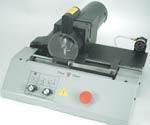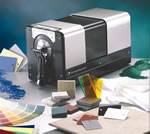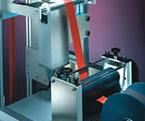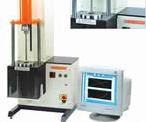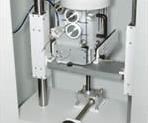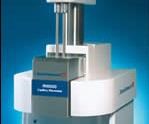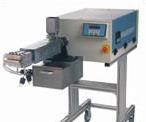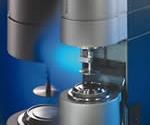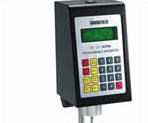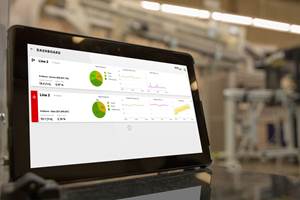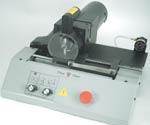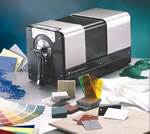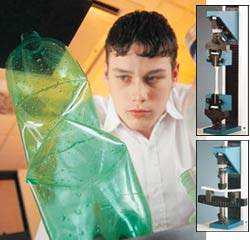Rheometers: Which Type Is Right for You?
Capillary and torque rheometers are good for simulating processing conditions, troubleshooting, and QC. But dynamic rotational instruments can tell you more about a resin's molecular structure.
Long used by materials suppliers to characterize the viscoelastic properties of polymer melts, rheometers are also becoming more popular among plastics compounders. Both groups use rheometers to assess resin processability for routine quality control and also as R&D tools to help determine which material best fits a process or application.
One reason for the broader use of rheometers in plastics is their declining prices, which is partly a result of the improving cost/performance trend in computer power. While six-figure tabs were typical in the past, instruments can now be had for under $40,000. The latest instruments also boast improved accuracy and both software and hardware accessories that expand the range of testing capabilities.
There are three main types of rheometers: capillary, torque, and dynamic rotational, and each serves a different purpose. For example, if you are looking for a more sophisticated version of a melt indexer, a capillary rheometer may be the instrument to consider. A melt indexer measures only one point on the shear-rate/viscosity curve, which offers only a crude indicator of flowability or average molecular weight. A capillary rheometer measures multiple points on the curve to give a more realistic picture of flow at the higher-shear conditions of injection molding (10,000 to 100,000 sec-1) or extrusion (100 to 1000 sec-1). Capillary rheometers can range in price from $30,000 to $45,000 for entry-level, benchtop QC units up to $100,000 for more advanced models.
There are also on-line capillary rheometers that measure viscosity of material as it passes through an extruder. They typically cost $100,000 to $150,000, though a couple of companies have introduced versions priced around $50,000.
Torque rheometers are essentially small mixers or extruders. They measure the torque on the mixing screws or rotors, which reflects how hard it is to mix the material. Machine torque, which can be correlated to viscosity, is one of the primary ways that a processor can characterize materials’ processability. Torque rheometers can range in price from $35,000 to $40,000 for a basic batch-mixing model up to $150,000 for a unit with a twin-screw extruder.
Both capillary and torque rheometers typically provide data on viscosity and melt flow as material passes through the instrument. In contrast, the purpose of dynamic rotational or oscillatory rheo meters is to probe into a polymer’s molecular structure and viscoelastic properties. These instruments place the plastic sample between two components, one stationary and one that turns back and forth at adjustable speed. These instruments operate at relatively low shear rates. They provide information related to how a resin will process and have proved vital to material suppliers in both R&D and QC functions. The cost range of rotational instruments used for plastics is $40,000 to $90,000.
High-shear viscosity data from capillary rheometers and low-shear data from dynamic rotational rheometers can be compared because they both measure “true” or absolute viscosity. That is not true of torque rheometers, which provide only a relative measure of viscosity through correlation with torque.
Instrument suppliers generally agree that compounders and processors looking for a QC tool with some level of research capability are likely to opt first for a capillary rheometer. Next up the scale is a torque rheometer, which allows you to troubleshoot flow in an extrusion die or injection mold and also can be used for QC. In addition, torque rheometers can mix batches of materials for testing and development, which is not possible with the other two rheometer types.
When processing problems cannot be diagnosed with either capillary or torque rheometers, the solution may require insight into molecular structure, which can be provided by a dynamic rotational rheometer.
(Not discussed here is another class of instruments known as viscometers, which measure only viscous flow properties—not viscoelastic properties—of liquids. Viscometers are used with liquid thermoset resins and rubbers.)
Capillary Rheometers
A high-shear, controlled-stress capillary rheometer consists of a heated barrel and a piston that drives molten material through a calibrated die, applying pressure either at a constant speed or a constant shear rate. Die geometry can be changed to measure rheological properties under different conditions. In addition to the most widely used single-bore configuration, there are also twin bore (dual-barrel) instruments that can perform two simultaneous tests under different conditions. There are also on-line capillary rheometers, which are mounted on an extruder.
Major suppliers of capillary rheometers include Ceast, Dynisco Polymer Test, Goettfert, Malvern Instruments (which acquired Bohlin Instruments/Rosand in 2003), and Thermo Electron (formerly Thermo Haake).
Although capillary rheometers can test a wide range of plastics, PVC poses difficulties owing to its release of corrosive hydrochloric acid, notes Gerard Nelson, sales manager for Ceast USA. Likewise, corrosion from water is a problem with PET, nylon, and other hygroscopic materials, according to Alberto Correa, product manager at Thermo Electron. However, with on-line capillary rheometers, oxygen is excluded from the testing process, so hygroscopic materials present no problem. Thermosets also can be processed in on-line capillary instruments but not in benchtop capillary models because the resins cure quickly and cannot be cleaned out.
Capillary rheometers can measure how a material’s viscosity changes as a function of temperature and pressure. One test can cycle through 10 different piston speeds at a controlled temperature and track how the viscosity changes relative to shear rate (rate of flow) and shear stress (force applied). The result is a rheology curve that plots shear stress, measured in Pascals (Pa), on the X axis and shear rate (in sec-1) on the Y axis. The ratio of the two is the viscosity in millipascal-seconds (mPas). One mPas equals 1 centipoise (cp), which is the viscosity of water at room temperature.
Benchtop capillary rheometers for quality control have a lower force range of 5 to 10 kN, compared with 50 to 60 kN for mid-range and higher level units. Benchtop QC models also typically provide piston-speed ranges of 20,000:1 vs. a 200,000:1 range for more advanced units used by R&D departments.
The most widely used capillary rheometers are single-bore models. Popular examples include Goettfert’s Rheotester 500 extrusion plastomer, which is both a rheometer and a melt indexer; Dynisco’s LCR 7001; Ceast’s Rheologic 2500; Malvern Instruments’ (Rosand) RH2100; and Thermo Electron’s (Haake) RheoCap S20.
A newer alternative is twin-bore capillary rheometers, some of which can be had for around $50,000. They save testing time by allowing you to get two results in one test cycle. Their other key advantage is that they can automatically calculate Bagley or other corrections, which translates into a truer measure of absolute viscosity. This is accomplished by using dies of the same diameter but different lengths, resulting in different shear stresses at the same shear rate.
According to Ceast’s Nelson, twin-bore units can also be very useful in detecting slip-wall effects. High slip at the wall may result from lubricants, pigments, or other additives. Excessive slip can indicate the need to reduce additive levels, which will save formulation cost and improve processing.
Popular twin-bore capillary rheometers include Ceast’s Rheologic 5000, Goettfert’s Rheotester 2000, Dynisco Polymer Test’s LCR 7002, Malvern Instruments’ (Rosand) RH 2200, and Thermo Electron’s (Haake) RheoCap T100.
Viscoelastic properties, too
Relatively new to capillary rheometers are hardware and software that enable them to measure or derive mathematically some viscoelastic properties such as extensional viscosity, die swell, and melt strength. Says Tim Haake, general manager at Goettfert, “Extensional or elongational viscosity is important for film, fiber, and foam processing as well as blow molding and is not obtainable with a typical rheometer.” Patented several years ago, Goettfert’s Rheotens is an extensional rheometer that sells for $60,000. Since then, other suppliers have come up with different ways to accomplish the same end, in some cases by means of software correlations or special hardware accessories.
Dynisco Polymer Test, for example, has developed new software routines that allow users to derive some viscoelastic properties, such as elongational viscosity, from shear-rate and shear-stress measurements. According to company president Rich Pavero, Dynisco also has developed software that provides excellent correlation of standard capillary data to the intrinsic viscosity (I.V.) of PET, a feature that reportedly has generated interest among PET compounders and processors.
Randy Byrne, v.p. of marketing at Malvern Instruments, says both the company’s mid-level RH2000 (Rosand) and high-level RH10 series (Bohlin) rheometers now can measure die swell through a combination of special software and hardware. The latter involves a high-resolution laser that measures the diameter of the polymer stream as it exits the die.
Malvern’s Rosand line of capillary rheometers measures extensional viscosity using a melt-strength device. These rheometers perform other processing-related measurements such as wall-slip velocity, melt fracture, thermal degradation, and stress relaxation. Similarly, Ceast’s rheometers can now be equipped with stretching units to carry out melt-tension analysis that provides extensional viscosity. Laser die-swell measurement systems are also available.
Ceast also now offers an equilibrium stress prediction (ESP) algorithm as standard software. Says Nelson, “In stead of waiting for the rheological curve to stabilize at each piston speed (shear rate), indicating the attainment of equilibrium stress, this algorithm can predict it early on, saving up to 60% of the testing time. We have generated data that shows a very good correlation between a full test and early ESP prediction.”
On-line models
Compounders and resin suppliers need not wait for lab test results on production samples every few hours: They can maintain almost real-time control of product quality with an on-line rheometer On-line rheometers process a side stream of melt diverted from the extruder. After testing, the melt is either discarded or returned to the extruder. Thermo Electron’s Correa notes that the company’s on-line Process Control Rheometer (PCR 630) is used by major resin producers whose extruders run 60,000 lb/hr. Clearly, they can’t wait to find out whether their material is on- or off-spec. The hurdle for other processors has been the cost of these units—over $100,000. Recently, two suppliers have introduced on-line models priced at around $50,000. Dynisco’s ViscoSensor is said to be the smallest return-stream on-line capillary rheometer, one that reportedly matches the capabilities of higher-end units. Says Pavero, “We have had compounders using it, as well as PET and polyolefin sheet and film extruders, higher-end PET recyclers, and extruders of nylon shapes and rods. A maker of PET sheet for thermoformed trays is using it as a viscosity and moisture analyzer, as they can monitor the I.V. number and quickly respond if dryers are not functioning adequately.”
Meanwhile, Thermo Electron developed an on-line system in Germany that is now being made available here. The ProFlow rheometer sells for a base price of $50,000, but it does not return the material to the main stream.
Among high-end models, Goettfert’s smaller on-line unit, the MBR, is used most often by PET processors to monitor I.V. during processing. The company’s Real Time Rheometer (RTR) is a return-stream system that has seen some use in plastics. “It can take up to one-half hour for some very viscous materials to go through an extrusion die, which means you can be making off-spec material for that half-hour. The RTR has an extra circulation pump that transports the material sample [to the rheometer] in 5 min,” says Tim Haake.
Torque Rheometers
The heart of a torque rheometer is a special motor that can measure the torque on its shaft. Its drive system can be coupled to interchangeable accessories like a miniature laboratory mixer or single- or twin-screw extruder. Suppliers of these instruments include C.W. Brabender and Thermo Electron.
The torque rheometer is connected to data-acquisition software that tracks the process torque, drive speed, temperature, and pressure. These data indicate how easily materials process and how readily different additives disperse. In the polymers industry, torque rheometers got their start with PVC and rubbers because of all the additives that go into these formulations. For example, a torque rheometer helps assess the sensitivity of a formulation to degradation. “This will show up as an increase in the torque curve of PVC as the material starts crosslinking,” explains Scott Martin, senior product specialist at Thermo Electron.
Andrew Yacykewych, applications laboratory manager at C.W. Brabender, says torque rheometers are now testing all types of thermoplastics, including nanocomposites and wood-filled plastics. Applications now also encompass thermosets, particularly unsaturated polyesters and phenolics, where the instrument is used to study curing behavior.
Processors using torque rheometers are primarily extruders of film, sheet, tubing, and coatings, according to Yacykewych. These small, precisely controlled extruders have also been used for small-volume production of products such as catheters.
Newer developments in torque rheometers include special sensors that are used by compounders and masterbatch suppliers to measure thermal and electrical conductivity as a QC check on dispersion quality or the performance of additives like carbon black, according to Thermo Electron’s Martin.
Compounders also use torque rheometers to simulate their twin-screw extrusion lines on a small scale. Thermo Electron’s new PolyLab system is a modular torque rheometer designed for process simulation in the lab or pilot plant. According to Martin, many compounders start with the small batch-mixer module for formulation work. “Once you have the base formulation, then you want to make the compound in a continuous fashion using the twin-screw extruder module. Material can be run through a pelletizer and then the torque-rheometer drive is attached to a single screw extruder that will process those pellets through a miniature blown film line and make actual bags.”
The company’s PolyDrive line includes less expensive rheometers with a dedicated mixer or extruder attachment that cannot be interchanged. For example, a PVC compounder who wants a unit to perform only PVC fusion tests may be satisfied with a dedicated PolyDrive mixer. PolyDrive systems with software cost in the range of $35,000 to $45,000.
C.W. Brabender’s top-of-the-line unit is the four-year-old Intelli-Torque Plasti-Corder, which features a precision digital servo drive with a torque range of 1 to 400 Nm over the entire speed range of 0.2 to 150 rpm. More recently, the company introduced the ATR Plasti-Corder, which has a smaller drive (2.5 hp) and costs about half as much as the Intelli-Torque. The ATR can apply up to 160 Nm of torque and can accommodate any Brabender mixer or single-screw extruder attachment.
New torque rheometer software from Brabender includes Winmix for batch mixers, which features evaluation routines for PVC, elastomers, polyolefins, thermosets, and engineering resins. Tests include plasticizer or liquid absorption, flow and cure behavior, heat and shear stability, fusion behavior of rigid PVC, and carbon-black incorporation time. Also new is Winext software for extrusion. It can assess a polymer’s viscosity under conditions similar to an actual processing environment.
Dynamic Rotational Rheometers
The primary components of a dynamic rotational rheometer are a motor, optical encoder, torque-sensing mechanism, and (for plastics applications) a means of applying force along the rotor axis. Another critical component is an air bearing that allows the rotor and torque sensor to “float” and minimize friction. Major suppliers of this type of rheometer include Thermo Electron (Haake), TA Instruments (including the former Rheometric line), and Malvern Instruments (Bohlin).
These instruments operate in continuous rotation and oscillation modes. Oscillation at a narrow angle is most often used for plastics. This small-strain oscillation provides information on viscoelastic properties, including melt viscosity, molecular weight, MW distribution, and polymer relaxation—all of which can affect how the material processes. These instruments’ software can plot elastic modulus and viscous modulus against oscillation frequency in radians/sec. This low-shear test runs a scan sequence from very short turns back and forth to wider-amplitude oscillations to simulate processing shear conditions.
There are three different types of stress-sensor attachments: cone and plate, plate and plate, or concentric cylinder. The last is used mainly for adhesives and coatings. Plate-and-plate (or parallel-plate) geometry is used to characterize thermoplastic melts and thermosets (disposable plates are necessary). Cone-and-plate is used primarily for steady-shear and normal-force testing, the latter of which correlates with die swell of thermoplastics. Creep studies on solid plastics can also be performed with parallel-plate or cone-and-plate sensors. In a creep test, a constant stress is applied to the sample and the strain is monitored. “Creep allows direct measurement of the equilibrium recoverable compliance and zero-shear viscosity,” explains Russ Ulbrich, product manager at TA Instruments.
Among the popular dynamic rheometers for plastics is the AR series from TA Instruments. It uses CMT (combined motor and transducer) technology. More expensive, but still quite popular for plastics, is TA Instruments’ patented SMT (separate motor and transducer) construction, which measures torque independently from the drive motor, greatly reducing calibration requirements. “With CMT devices, there is a need to correct for inertia of the system,” says Ulbrich. His firm’s Rheometric Ares SMT rheometers decouple torque sensing from the motor, thus overcoming the problem of inertia contribution, Ulbrich explains.
For example, CMT rheometers can have difficulty measuring very low viscosities because the inertia of the rotor and sensor becomes very large in relation to the resistance offered by the materials. Problems also can occur in analyzing materials like thermosets that show large changes in viscosity during processing. Users may encounter inertia limitations on CMT rheometers as the polymer cures. But Ares rheometers with SMT technology reportedly can measure the whole range of viscosities accurately.
CMT devices measure controlled stress but not controlled strain. “Traditionally, CMT devices have been only able to control strain in oscillation using iterative feedback loops, which required several oscillation cycles to achieve the programmed strain. This lengthened the testing time. SMT devices never had this limitation,” says Ulbrich. Advances in CMT devices now allow a user to hit the programmed strain within the first oscillation, like a SMT device, but additional calibrations are then needed. An example is TA Instruments’ AR Mobius Drive 2000 system, which can be equipped with accessories such as an oven for thermoset cure studies. Says Ulbrich, “This system can directly control strain and stress in oscillation and do controlled strain-rate/stress-relaxation tests on one platform.”
Similar benefits are claimed for Malvern’s Bohlin Gemini and C-Vor CMT instruments, whose Rotonetic drive can make both controlled stress and strain measurements. Thermo Electron’s two-year-old RheoStress 600 has an ultra-low-mass motor that reduces inertial effects during testing. Another interesting feature is the measurement of normal force (along the rotor axis). Says applications engineer Jenni Briggs, “Forces acting perpendicular to the direction of flow play an important role in many rheological applications. With RheoStress 600, the normal force can be used as a set parameter as well as a measured variable. The normal-stress differences induced by shearing a viscoelastic sample are measured by the normal-force sensor integrated in the air bearing.”
The instrument’s MFC (Micro Force Correction) feature extends the measurable force range down to 0.01 N (0.002 lb). In the FLC (Forced-Controlled-Loading) mode, samples are loaded under a preset normal force in order to increase reproducibility.
A low-cost alternative
A very different type of dynamic rotational rheometer is sold by Brookfield Engineering Laboratories. Its “cone spindle” (cone-and-plate) instruments rotate continuously and have mechanical bearings. While they are not as sensitive as air-bearing instruments and do not perform oscillation tests, they are significantly less costly. They are recommended for QC and some types of polymer characterization. Explains marketing director Bob McGregor, “The air-bearing instruments tell you more precisely the yield value of the material and provide greater detail on its elastic modulus, which is important for analytical studies. But for more basic characterization our instruments may be very suitable.”
Brookfield’s R/S controlled-stress rheometer, which sells for $12,000 to $20,000, applies constant or ramped speeds and also can vary the amount of normal force to permit direct measurement of yield and creep behavior.
Brookfield recently introduced the DV-III Ultra, which sells for just $3995. It replaces the former DV-III+ model, a controlled-rate instrument that measures how a material behaves at constant shear rate. The upgraded Ultra version combines the capabilities of the DV-III+ with the yield-stress measurement capability of Brookfield’s YR-1 yield-test rheometer. McGregor says the DV-III Ultra, when used with vane spindles and Brookfield’s EZ-Yield software, can provide viscoelastic data on storage and loss moduli comparable to that obtained with higher-end air-bearing rheometers. Adds McGregor, “We are now developing a method that will allow us to determine the phase angle—something that is now only provided by instruments that perform oscillation tests.”
Related Content
How Inline Vision Inspection Can Minimize Scrap in Molding
Once viewed by injection and blow molders as a necessary evil, machine vision technology today can continuously monitor and improve production while reducing costs.
Read MoreUsing a Melt Flow Indexer to Test Your Pressure Transducer
The MFI tester enables collection of meaningful pressure data in transducers in a relatively short time, providing realistic measures of the response time of a pressure transducer. This information is critical in the interpretation of pressure data measured in an extrusion process.
Read MoreCP Cone, Plate Viscometers Built for Precision, Consistency
Units feature a robust direct drive motor and an electronic cone lift for precise and consistent results.
Read MoreAvient Receives PLASTICS’ 2023 Re|Focus Sustainability Innovation in Design Award
Said to be the first digital tool of its kind, the award was for Avient’s post-consumer recycled resin Color Prediction Service.
Read MoreRead Next
IMPACT: Which Test to Use? Which Instrument to Buy?
Impact testing is a complex and controversial subject, and one that is in the midst of change. These factors add challenge to selection of the most appropriate impact instrument for a processor's lab.
Read MoreTesting & QC at NPE 2003
Plastics molders, extruders, and compounders will have a lot to see in testing and measurement equipment.
Read MoreHow to Buy Universal Testing Machines
More processors today are buyingso-called ‘universal’ testers to measure tensile, flexural, compressive, and shear properties for materials evaluation, application development, and quality control. Advanced electronics have improved these instruments’ performance and ease of use—and even led to lower prices.
Read More

